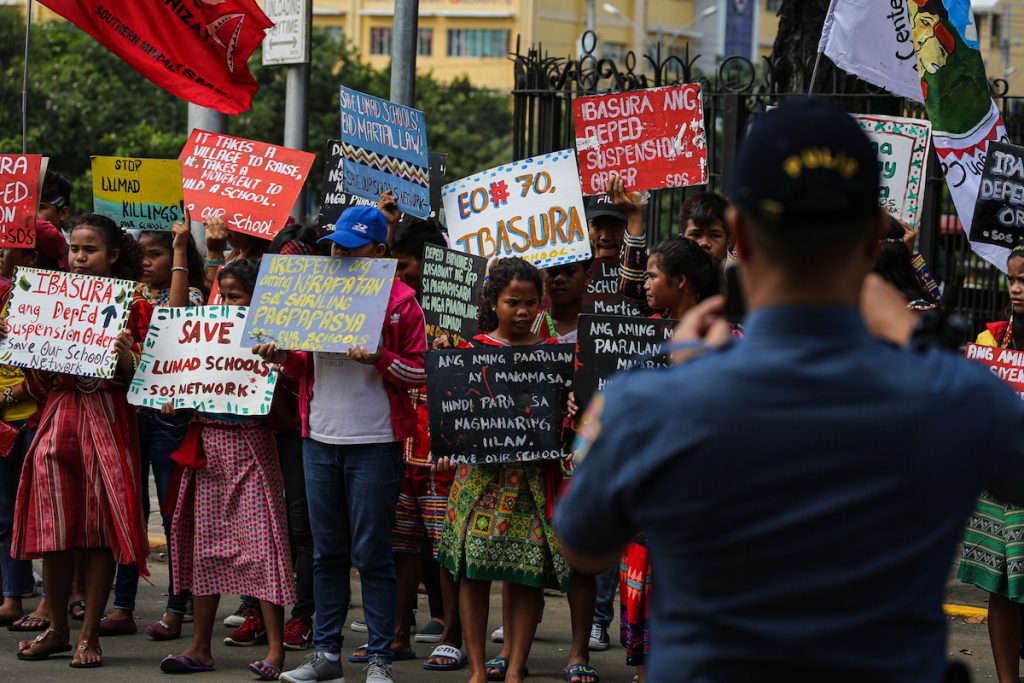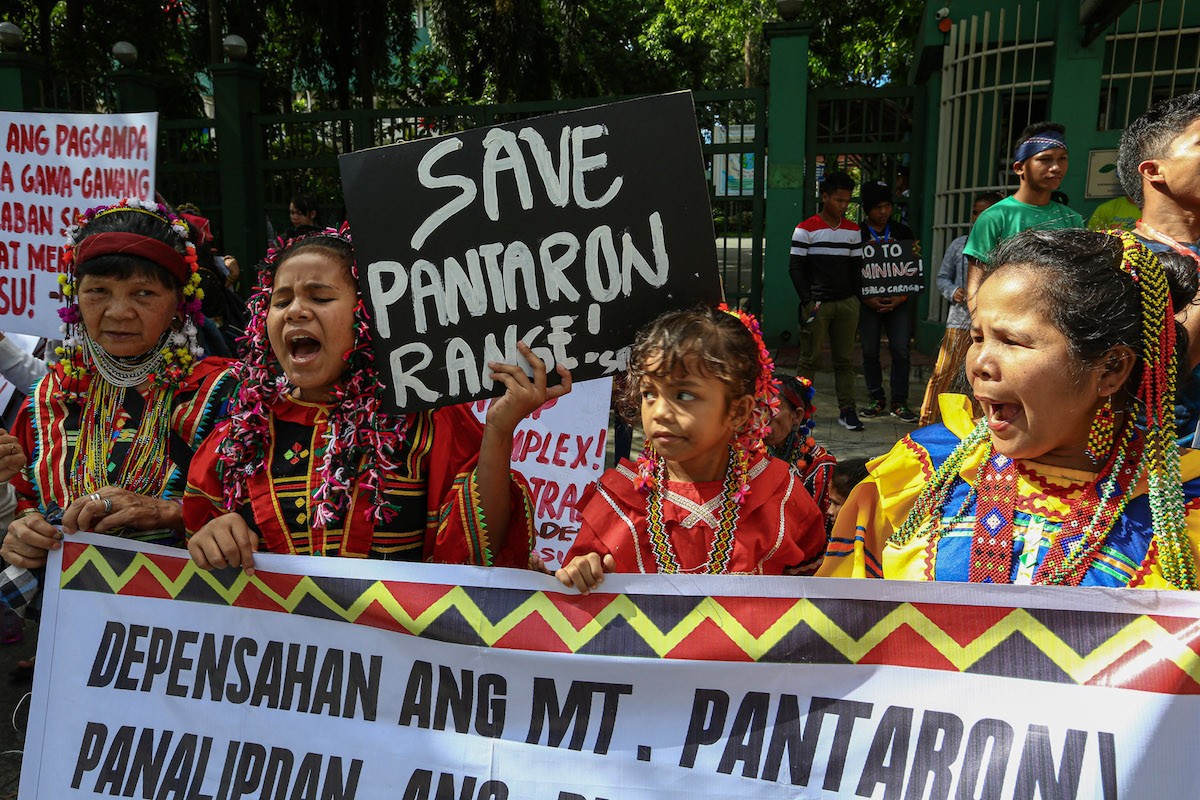Police in the southern Philippine city of Davao, home turf of President Rodrigo Duterte, have allowed paramilitary forces, who attacked a religious sanctuary for indigenous peoples, to walk free.
Instead, they turned on the targets of the attack.
Authorities threatened to fast track the filing of charges against supporters of the Haran Mission Center of the United Church of Christ in the Philippines (UCCP).
Leaders of about 400 displaced Manobo tribal people from conflict-rocked communities high in the mountains have also become targets.
Members of the paramilitary group Alamara, which includes relatives of the refugees, descended with steel blades and wire cutters on the center.
They destroyed part of the UCCP compound fence before male refugees forced a tense stand-off.
Police eventually arrived but claimed they saw no armed men. Instead, they barred the entry of Haran staff and members of the clergy, including UCCP minister Rev. Dan Palicte.
The city’s vice mayor, Sebastian Duterte, the president’s son, later came to “mediate” a dialogue.
This was not an isolated incident.
Ten days before, the regional peace and order council of mayors and governors, and police and military officials, passed a resolution to close the church compound.
They alleged various terroristic activities, and child abuse and serious illegal detention offenses linked to human trafficking.
Twisted concepts
The refugees stood pat.
Bishop Hamuel Tequis of the UCCP Southeast Mindanao Jurisdictional Area said they would not abandon the church’s commitment to act as shepherds to the poor and the deprived, the oppressed, and the marginalized.
The police, which claimed it had nothing to do with the attack, lashed out at indigenous tribal leaders, sanctuary staff, and the media for preventing the “rescue.”
This isn’t the first time authorities have used that word, or twisted the meaning of other terms, to justify human rights violations.
Duterte of course rationalized tens of thousands of killings of suspected drug users and pushers as his way of saving Filipinos.
During the two-decade dictatorship of Ferdinand Marcos, “salvage” was an extra-judicial killing aimed to prevent the loss of communities to Asia’s longest-running insurgency.
In the last half decade, “rescue” has become a euphemism for operations aimed at forcing back dissenters to their isolated villages, where they are then forced to surrender and then conscripted to paramilitary groups.
The word was used by the government of Duterte’s predecessor, President Benigno Aquino III, in 2015 when a woman legislator and truckloads of Alamara militia and military and police escorts tried to force their way through the gates of Haran.
Nancy Catamco, a former member of Congress, posted on social media the image of the tribe’s chieftain, Bai Bibiyaon Ligkayan Bigkay, with the caption “She wants to go home.”
The tribal chief confronted the legislator. Using Manobo warrior language and gestures, she accused Catamco of deceit, of twisting the people’s words, message, and demands.
The same accusations would be echoed by then U.N. Special Rapporteur for Displaced Persons Chaloka Beyani, who also said there was no human trafficking or involuntary detention among the indigenous persons in the Haran sanctuary.

Our land is your land
“We can’t go back because we are accused as [New People’s Army] …. I will not go back because things will be the same. I will face death in the hands of the soldiers and the Alamara,” said Bai Bibiyaon.
In 2015, the Duterte clan bannered itself as a champion of the rights of indigenous peoples and farmers.
Today, a third of about 200 activists killed since Duterte assumed power in 2016 came from the ranks of indigenous tribes battling mining firms and plantation developers.
Some of the killings are blamed on the government armed forces, others on paramilitary armed bands. These groups are a proxy army, nominally supervised by the government forces, a tool to evade accountability.
Military officials have claimed that more than half of the communist New People’s Army guerrillas in Mindanao come from indigenous tribes. If that estimate is right, many factors feed the well of recruits.
Datu Tungib Mansumay-at, one of the leaders of the Talaingod tribe, said they are not just defending their right to leave in dignity and freedom.
“If they destroy the Pantaron range, we will lose our home. But we won’t be the only ones affected. The Pantaron range connects all the waterways that feed the Davao region, including the mighty Pulangi and Capalong rivers,” he explained.
Duterte has only fanned the flames of rebellion. During his presidential campaign, he cursed miners, railed at environmental destruction, and promised to bring home displaced tribal people.
He did bring them home. But peace was not to be found. Instead, the president soon warned tribes that he would choose investors for their lands to spur development.
As resistance stiffened, he ordered massive military operations against “communist front groups.”
Government agencies target civilians perceived as communist supporters. On military prodding, the education department has closed about 50 indigenous schools — some, in areas with very high illiteracy rates, with the first generation students.
The Duterte administration has also cracked down on the Rural Missionaries of the Philippines, which has decades of experience helping Mindanao’s indigenous peoples.
Then and now, national officials think “rescue” is the synonym for surrender — of rights, of land, of life itself. Mindanao’s indigenous tribes, tempered by a century of defending ancestral territories, are not about to surrender.
Inday Espina-Varona is editor and opinion writer for various publications in Manila. The views expressed in this article are the opinions of the author and do not necessarily reflect the editorial stance of LiCAS.news.







